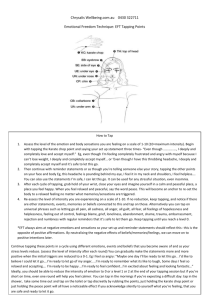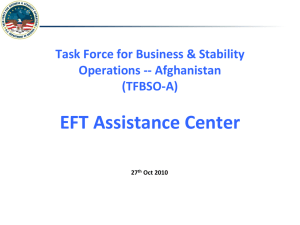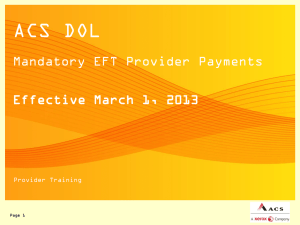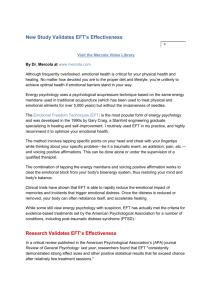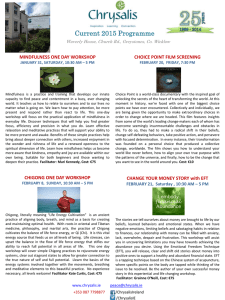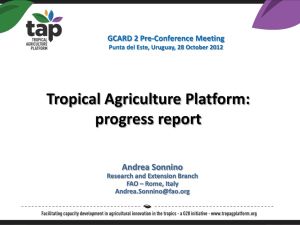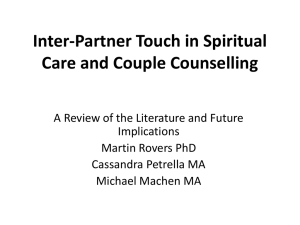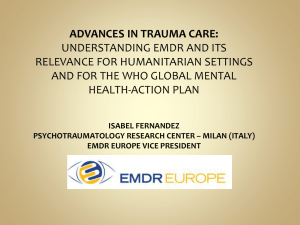powerpoint
advertisement
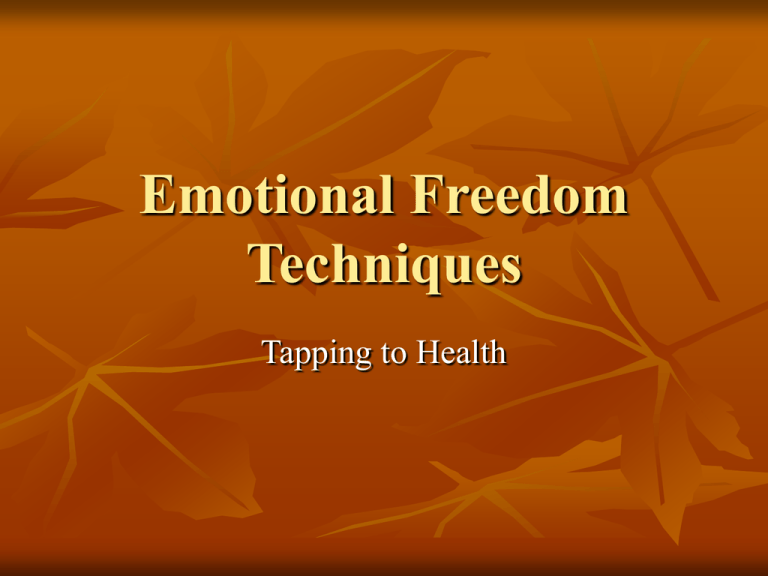
Emotional Freedom Techniques Tapping to Health What is EFT? It is a very simple procedure that anyone can learn and use to alleviate stress or anxiety, and all the ways those emotions manifest themselves in our lives. EFT: What is it? EFT is “like acupuncture without the needles.” In fact, new research indicates that simply tapping on meridian points is every bit as effective at relieving symptoms in the body as acupuncture. What is EFT? Tapping can be used to address the everyday stresses, emotions, frustrations, and aches and pains that we all have. It can relieve headache pain, even migraines. It can help you fall asleep. It can enhance your performance. Tapping is VERY good for all of that!! And, it’s something so simple to use that even children can easily master it! We’re Going to Give It A Try! RIGHT NOW! But first…….. Before we begin: On a scale from 0 to 10: with 0 being the least possible stress, and 10 being the highest level of stress imaginable… what number would you assign to your stress level now? How can Tapping Work on so Many Different Things? HEADACHES DIFFICULTY SLEEPING STRESS KNEE AND JOINT PAIN IMPROVING YOUR GOLF SCORE FEARS AND PHOBIAS Test Anxiety Fear of Public Speaking Limiting beliefs How is it possible? How can something as simple as tapping do so much to impact the body in a positive way? The Miraculous Body Think about taking a bite of food. You take that bite of food and your body immediately puts it to work in numerous ways to produce nourishment and health. The Body Can utilize the healing aspects of EFT in the same way. We’ll be talking about exactly how EFT works as a calming mechanism within the body in just a few minutes. So, The Question Is… Do you have two minutes to invest in your own wellbeing? Because that and EFT are all you’ll need to rid yourself of the stress that can lead to illness, or to a lack of productivity, or to less happiness and joy than is possible in your life. Because… If any of those issues present a problem for us, it is because stress and anxiety define our relationship to them. Tapping treats the anxiety. How does Tapping work? Until very recently, it was our understanding that EFT worked by removing blockages to the free flow of your body’s energy system. And, this is true. It does that. How Does EFT Work? In the same way that blood flows through your body, energy flows through you as well. We ARE energy, just as everything in the universe is energy. How does it work? “The cause of ALL negative emotions is a disruption in the body’s energy system.” -Gary Craig, founder of EFT, a form of Meridian Tapping The fact is: If you never use tapping for anything beyond those things that create daily stress in your life… … it will be one of the greatest gifts you’ll ever receive. Pass it on to others, and you’ll be giving an amazing gift to them as well. How does EFT Work? In the last few years, new research on EFT has expanded our knowledge and understanding of exactly how Tapping positively impacts the body… How does EFT work? Studies on the brain reveal that tapping on specific meridian points using the EFT protocol actually sends a calming signal throughout the body, particularly to those areas where anxiety or the “fight or flight” response is being held and is causing you distress. This distress can show up in your body as an emotional or physical symptom, or both. Some of you may have heard of EMDR. You might be wondering how EFT is like, or not like, EMDR. Let’s answer that question right now. How is EFT like, or not like, EMDR EMDR… stands for Eye Movement Desensitization and Reprocessing In 1987, Francis Shapiro discovered quite accidentally that bilateral stimulation could assist the brain in processing trauma. Bilateral Stimulation There are a number of ways to create bilateral stimulation within the brain. EFT VS. EMDR Alike? Different? You might say, they are both a little “strange”, at least in the way we normally think about healing. EFT and EMDR They are quite different in how they work within the body, and yet, the results they achieve may look very much the same. They may be thought of as spokes of the same wheel. How EMDR works: EMDR works by activating the client’s information processing system through bilateral stimulation. It involves an 8 – step process* and a trained clinician is expected to guide the process to facilitate a successful reprocessing of a traumatic event. How does EMDR Work? EMDR seems to have a direct effect on the way that the brain processes information. Normal information processing is resumed, so following a successful EMDR session, a person no longer relives the images, sounds, and feelings when a traumatic event is brought to mind. You still remember what happened, but the strong emotional charge attached to the event is dulled or removed entirely. That sounds very much like what happens in EFT. How does EMDR Work? EMDR appears to be similar to what occurs naturally during dreaming or REM (rapid eye movement) sleep. Therefore, EMDR can be thought of as a physiologically based therapy that helps a person see disturbing material in a new and less distressing way. How does EMDR work? American Indians engaged naturally in bilateral stimulation as a way of processing events. When returning from the hunt, they danced around the campfire to the beat of a drum and told their story of the adventure. EFT and EMDR EFT, on the other hand, works directly on the body’s energy system. EMDR and EFT achieve very similar results and both have been shown to be extremely effective in the treatment of trauma, or PTSD. Why EFT? For me, the beauty of EFT is that it puts your healing in your own hands. It takes away the need for a clinician to facilitate the process. You don’t have to make an appointment and wait until the clinician is available. You can use EFT right NOW!! Will tapping work for me? In order for tapping to work, you have to be WILLING to give up your symptom(s). Not everyone is willing to give up their symptoms. Sometimes there is secondary gain involved. Ask yourself: Is this issue serving me in some way? Giving up your symptom… Maybe the symptom is too tied to your identity. Who would you be without the symptom? “If I tap on this symptom, what’s going to have to change?” Am I ready for that? Ask Yourself… Ask yourself: “What is the downside of letting go of this problem/ symptom?” “What is the upside of holding onto it?” Let’s Dig… A LITTLE DEEPER NOW into what tapping is capable of doing for you. Brain Plasticity As recently as the 1970’s we believed that after the teen years our brains were unchangeable. Research on brain plasticity has changed all that. Brain Plasticity Now we know that the brain is able to change and change rapidly. Trauma is laid down rapidly in the brain, and healing can occur just as rapidly, as it does with EFT. Stress Hormones When the body/brain suffers a trauma, or even the memory of a trauma, it releases stress hormones into the brain… adrenaline and cortisol. Stress Hormones Cortisol is referred to as “the stress hormone” because it is released in high quantities during the “flight or fight” response. Cortisol Higher and more prolonged levels of cortisol in the bloodstream (like those associated with chronic stress) have been shown to have negative effects, such as: Impaired cognitive performance Suppressed thyroid function Blood sugar imbalances such as hyperglycemia Decreased bone density Cortisol Higher and more prolonged levels of cortisol in the bloodstream can produce… Decrease in muscle tissue Higher blood pressure Lowered immunity and inflammatory responses in the body, slowed wound healing, and other health consequences Today We Life High Stress Lives Stress has become almost a “normal” and accepted part of our lives. Almost universally, people acknowledge the high stress levels they live with every day. Here’s Some Very Good News… Research has demonstrated that tapping is able to dramatically and quickly lower cortisol levels in the body. Epigenetics The field of epigenetics is also changing our understanding of how the body works. Research in the field of epigenetics shows how the functioning of a gene actually changes as a result of the environment the gene exists in. What does that mean? Epigenetics Epigenitics Well, it means that a person’s emotions, thoughts, and experiences of a traumatic nature, or of a spiritual nature, etc., actually impact the functioning of their genes. Dr. Bruce Lipton Dr. Bruce Lipton is a cellular biologist and a pioneer in the field of epigenetics. His work shows scientifically how “your beliefs actually change the cells in your body”. You can read more about it in his book, The Biology of Belief. What does EFT have to do with Epigenetics? Tapping is an excellent way to get at and release the underlying belief structures that limit us… and now we know… can actually define us at a cellular level. So, it’s not just our energy system that’s impacted by tapping… It’s the limbic system in our brain … that controls the “flight or fight” response. It’s the hormonal system that controls the release of stress hormones in our body. It’s our genetics as well. Tapping is New To You? We live in a culture in which the medical model is supreme. That means not fully recognizing and accepting that “body and mind are one” entity. We live in a culture where we are most comfortable leaving our health decisions in the hands of the “experts” (doctors, psychiatrists, therapists) who will instruct you as to what you must do to be healthy. But… Let’s just imagine for a moment that YOU are the expert on YOU! REALLY How can anyone know YOU like YOU do??? Maybe… You can take a much more active role in your own healing and wellness than you might imagine, or than you currently do. How EFT Helps and Heals How are those blockages in our energy system produced? Where do they come from? Well, believe it or not, they come from our thought patterns. How EFT Helps and Heals Remember what Gary Craig said: Negative thoughts or memories create negative emotions which result in a disturbance, or blockage, in our energy system. “But I’m a Positive Thinker!” We have somewhere between 12,000 and 60,000 thoughts per day… Yet, only 7 percent of our thoughts rise to a conscious level. Conscious vs Unconscious Fully 93 percent of our thoughts each day remain at an unconscious level, where they are not assessed, edited, or judged for their merit. Sooooooo… If only 7 percent of our thoughts are at a conscious level, then it’s the 93%, or all the unconscious thoughts, that are “running the show” of our lives most of the time. And… That can be a problem. Because it’s the way we think about things that creates our experience of them. What happened? Why do I see it this way? Up until the age of six, you were like a small but powerful computer… You simply downloaded … everything that came at you. (All the good stuff, but also All the negativity, the pain, the rejection, the fear, the sense of abandonment, even the trauma.) You downloaded it all… … without having the maturity or the insight to be able to edit it, or refute it, or simply discard it as wrong. No, not you? No, we didn’t all live with mean, awful people bent on damaging us. True, some of us might have. Many of us grew up with well-intentioned, loving families, …were educated by caring teachers…and yet we STILL felt hurt, pain, and rejection. What this is Not! It’s Not about “finding someone to blame” for the limiting beliefs you have about yourself today. And, please understand this… You’re In Good Company There are very few of us who don’t have beliefs about ourselves that hold us back from realizing our full potential in some way. You are in good company on this! So, here it is…. Those beliefs that you “downloaded” as a young child, that said something to you about yourself…. that defined you and created a pattern of limiting beliefs about yourself and your capabilities, and the possibility of being able to fulfill your dreams….. Those beliefs continue to inform your decision making and your beliefs about yourself TODAY! Why Tap??? It’s not what happened to you in the past that’s the problem – it’s how you think about yourself today as a result of that event. When you tap… The details of the story don’t change, but the thinking/the perception/the emotional charge the story holds for you, does. The Good News What you’ve made up (about yourself) you can unmake up. (Not the trauma itself, but what we tell ourselves or believe about ourselves as a result of that trauma.) Traumatization is an “inside job”. Why does it matter? Whether you believe something negative, or something positive about yourself as a result of the things that have happened in your life, you’ll continue to have experiences that support that belief. The thoughts you put out attract experiences, people, etc, that are an exact match. Why does it matter? Sometimes things happen and we say, “Why is this happening to me?” The more “productive” question might be: What am I believing about myself to have this experience in my life? Let’s tap on Limiting Beliefs Those small “t” traumas We are more likely to confuse the small stuff – the “small t” traumas – with who we really are. Many people come to see “Big T” trauma as something that strengthens them… They survived it! When you tap…How do these things show up? You may notice memories, events, or moments from long ago, suddenly popping up in your mind. You’ll be tapping on anger, and you’ll remember something… something that doesn’t feel at all related to what you’re tapping on right now… And, yet??? Don’t be too quick to dismiss those thoughts or ideas as “not relevant”. Why People Don’t Heal….. Surprisingly… It may be easier to hold on to the anger than to bump up against some of the issues that may arise if you really examine it. Bear in mind Resistance is “feedback” It doesn’t necessarily have to get in the way of growth. Reaching for Congruence Congruence is what’s critical: What you state to yourself and the world out here, “in consciousness”, has to match what you’re telling yourself on the inside, unconsciously. The unconscious mind has a mind of it’s own… The language of the unconscious is where all change occurs. It needs to be able to trust that it’s safe to change. For some, the spiritual answer to being wronged is to “Forgive and Forget”. Trauma (undischarged) is a lot closer to “the rock in the shoe.” You have to bring the unconscious to the conscious level in order to heal it. No one is “stuck” – they’re afraid. Everybody wants change, but nobody wants anything to be different. What will change? If I address this, what “else” will have to change? I might have to learn to say “No”, or to be more visible in the world, etc. What pushes your buttons? Things that trigger you: You have to have a template inside of you for it to bother you (now). Your triggers… You wouldn’t be worried about being called “stupid” (or moody, or incompetent, etc.) if you didn’t already have a template for it inside you. So, the question to ask is: “Do I remember a time in the past when I was made to feel that way…?” “Do I remember a time when someone I cared about made me feel stupid, or called me “stupid”, or treated me like I didn’t know anything?” If so, that’s important tapping material. Symptoms as Blessings Appreciate your symptoms….believe it or not, they are trying to help you. They are talking to you, and they will continue to talk, louder and louder, until you hear them. Remember: This “problem” was once a solution. Once we “pop a symptom” then we have something to work on, to tap on. What was going on in your life before, or at the time, your symptoms came on? People often ask… Am I saying the right words when I tap? There are no “Wrong” words! If it helps, write down all the negative selftalk that fills your head on the subject… THOSE are the words and phrases you need to tap on. And, be as specific and detailed as possible. For example… “I’ll never be a success.” “I’m no good at this kind of thing.” “People would reject me if they knew…” “I’m a total failure at _____________.” “Bad things always happen to me.” Henry Ford said… “Whether you believe you can, or you believe you can’t, you’re right!” And, remember… Positive thinking is great, but it only exists at the conscious level. You have to clear the negative/limiting beliefs you hold about yourself at the unconscious level. Tapping Strategies The “Tell the Story” technique: Just tell the story of what happened, and tap as you do. (Keep answering the question: And then what happened?) Ask “What if” statements as you tap: “What if I decided to accept myself?” “What if I believed it would all work out?” Tapping on Pain Working with Pain: A way to view the pain: My body is trying to talk to me – and I’m not listening. What is my body trying to tell me? My body is pretty smart, and I’m ignoring it. If the pain in your knee was trying to tell you something – what do you think it would be? If my pain was an emotion, what would it be? Remember: What’s your Number? But first…before you begin… “On a scale of “0 – 10”, with ten being the highest level of distress possible and 0 being no distress at all, how distressing does this event/memory/thought feel when you think about it now? It’s important to determine this so you can gauge the effectiveness of your tapping. To begin… Begin with a couple of rounds where you really explore and acknowledge your negative feelings about the issue. If you could choose… Then…you can suggest a transition, another way to think about it as you tap. How would you like to feel about this? “I choose… …to see this situation as part of my growth.” …to accept that I don’t have to be perfect.” …to see this person as trying to help me. …to feel confident and competent in this situation. I am willing… “Even though I feel so much anxiety about this… - I am willing to see it in a calm and stress-free way.” - I am willing to see it as helping me.” - I am willing to be calm and relaxed every time this occurs.” Tap “before” something… It helps to tap in advance of something… An event A presentation A social/family gathering An interaction with a person/client/colleague that you feel might be stressful This can instill positive energy that will create a much less stressful and more successful experience. After you’ve tapped… And, you’ve taken a deep breath and let it out sloooowly: Now…ask yourself… “What do I notice?” “What’s coming up for me now?” (There are no “right or wrong answers here. Just notice.) What thoughts, if any, has the tapping triggered for you? After you’ve tapped… In the end: You have to test your work! After you’ve tapped… You have to look at the issue you’ve tapped on…tell the story again, or picture the situation again. Test your emotions, your feelings on the topic. Where are you now? (Scale of 0 – 10) Aha moments? Write down your “Aha” moments…those ideas/thoughts that come forth at the end of a round of tapping, if you don’t plan to tap on them right then. Aha Moments They can be valuable gems of wisdom as to where the trail leads…what you should tap on next. But if you don’t tap on them immediately, they can easily get lost in your unconscious again. It happens to me all the time. Finally…You should be aware: What happens with tapping goes far beyond what occurs for you during the actual tapping experience. Finally… The result/effect can come in days later and you only notice because you’ll find you are responding differently to a situation. If you need help… Sometimes the most difficult thing is to figure out what questions to ask yourself in order to find the underlying issues to tap on. If you need help… While you can tap on your own and make very good progress, there may come a time when you would benefit from working with a practitioner in order to better focus your work. Finally… We are so much more than we believe ourselves to be. Finally… We are so much more capable, more powerful, more in every way than we could ever imagine. Knowing… We are infinite and vast and there’s a part of us that KNOWS this, knows that we are so much more than our bodies and our past traumas – and our limitations. You can heal your life! This Knowing really makes the difference. Knowing you can heal allows you to believe in the possibility of healing in others. You will telegraph that belief to others. Healing is a process, not an event! Every moment is a left – right moment! With each step you take… ALL YOU NEED TO DO IS TURN SLIGHTLY, IN THE DIRECTION YOU WANT TO GO. Use EFT And you WILL get to that place of peace and healing…that place you want to be!
